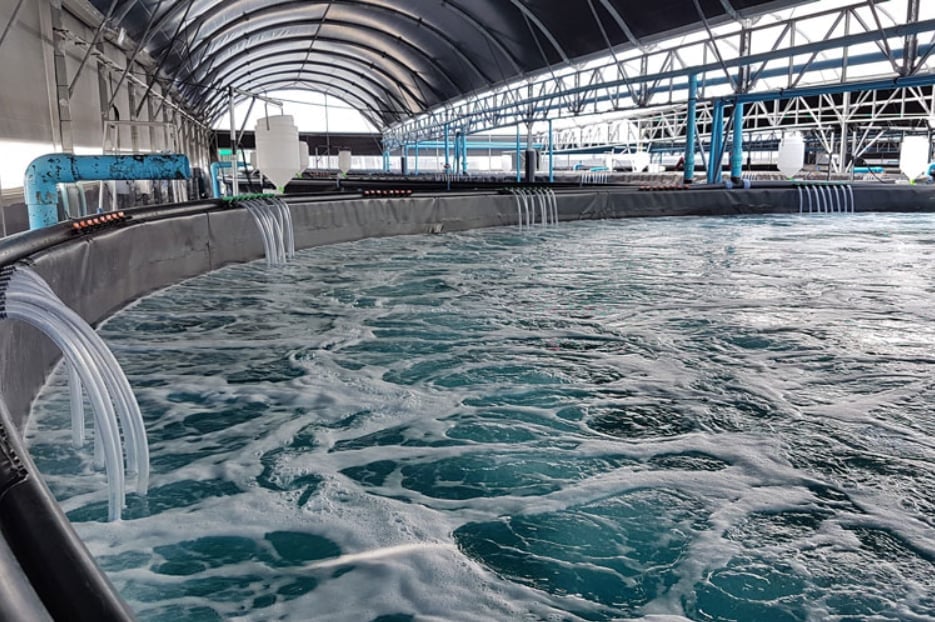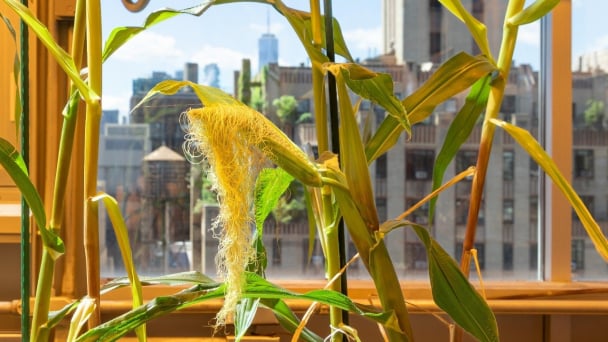June 3, 2025 | 10:10 GMT +7
June 3, 2025 | 10:10 GMT +7
Hotline: 0913.378.918
June 3, 2025 | 10:10 GMT +7
Hotline: 0913.378.918
Climate change, environmental pollution, and disease outbreaks are posing increasingly serious challenges to the aquaculture industry. In this context, the question is no longer what to farm or where to farm, but rather how to farm in a way that is sustainable, efficient, and ecologically safe.
From recirculating aquaculture systems (RAS) and integrated multi-trophic aquaculture (IMTA) to applications of artificial intelligence, biotechnology, and urban aquaponics. The high-tech approaches are gradually taking shape.
Although still relatively new in Vietnam, with clear investment strategies, timely policy support, and well-aligned market orientation, these technologies could become the key to unlocking a sustainable future for the industry.
RAS (Recirculating Aquaculture System) is a closed-loop farming model in which 90-95% of water is continuously reused through a series of biological, mechanical, and UV or ozone disinfection filters.
As a result, environmental parameters such as pH, temperature, dissolved oxygen, ammonia, and nitrate levels are closely monitored. This allows for significant water savings, effective disease control, and reduced environmental treatment costs.

The operating principle of the RAS system is based on the continuous circulation of water through biological, mechanical, chemical, and physical filtration processes to maintain optimal water quality for the cultured species. Photo: Vietnam Aquaculture.
According to the Atlantic Sapphire Annual Report (2023), in the United States, Atlantic Sapphire’s salmon farming project in Florida, backed by an investment exceeding USD 500 million, is considered one of the largest RAS models in the world.
Meanwhile, according to FAO (2022), in Israel, where water resources are extremely scarce, RAS has become an essential component of the country’s high-tech agricultural strategy since the 1990s.
In Vietnam, over the past five years, RAS technology has started to gain more attention. Several pilot models have been implemented in Lam Dong (sturgeon), Khanh Hoa (grouper), the Mekong Delta (mud-free eel), and Binh Thuan (whiteleg shrimp).
According to statistics from the Department of Fisheries and Fisheries Surveillance, as of 2023, Vietnam had about 20 to 30 medium-scale RAS projects, mainly concentrated in Dong Nai, An Giang, Lam Dong, and Binh Thuan.
However, the biggest barrier remains the high initial investment cost, ranging from VND 5 to 7 billion (approximately USD 200,000 - 300,000) for every 1,000 square meters. In addition, challenges include a shortage of skilled technical personnel, non-standardized operating procedures, and an unstable market for RAS-raised products.
IMTA is a model that cultivates multiple aquatic species in the same system. The concept is inspired by natural ecosystems: waste from species such as fish or shrimp, fed with commercial feed, becomes a nutrient source for seaweed, shellfish, or other water-filtering organisms.
This approach not only helps reduce organic pollution and mitigate toxic gases, but also contributes to restoring coastal ecosystems, especially in areas under heavy environmental stress. Canada has been a pioneer in IMTA research and application through its Department of Fisheries and Oceans (DFO). China is also accelerating IMTA adoption with integrated models combining marine fish, seaweed, and clams in provinces such as Shandong and Fujian.

Principle of the RAS-IMTA technology. Photo: Dr. Nguyen Nhut.
In Vietnam, the IMTA model has been piloted in scattered locations such as Van Don (Quang Ninh), Con Dao, and Nha Trang. However, most implementations remain within the scope of research projects or are carried out independently by large farming households. The lack of zoning plans for aquaculture areas, along with limited access to credit and insurance policies, has prevented the widespread adoption of this model.
At the same time, aquaponics integrating of fish farming and hydroponic vegetable cultivation in a closed-loop system, is gaining interest in urban areas. Models such as Sky Greens (Singapore), Superior Fresh (USA), and others in Sweden and Northern Europe serve as clear examples of this trend.
In Vietnam, aquaponics systems have appeared in Ho Chi Minh city and Da Lat, but are still primarily used for educational and experimental purposes. They are not yet commercially viable due to high setup costs and the absence of concrete policy support.
Smart aquaculture is gradually becoming the new standard. Instead of relying on visual observation, farmers can now monitor pond environments in real time through IoT sensors, tracking salinity, temperature, dissolved oxygen, pH, and more.
AI can analyze abnormal fish behavior to provide early warnings of disease, automatically adjust feed quantities, and optimize harvest timing.

Application of Internet of Things (IoT) technology in shrimp farming. Photo: Illustration.
According to the China Aquaculture Report (2022), in China, Alibaba Cloud’s AI system has helped reduce shrimp feed usage by 30% while increasing production by 25% compared to traditional methods. In Vietnam, major industry players such as Minh Phu, Vinh Hoan, and Nam Viet have begun deploying management software, attaching chips to monitor ponds, and testing 24/7 surveillance cameras.
However, according to a report by the Vietnam Fisheries Society (VINAFIS), these technologies are still in the pilot phase and have not yet been widely scaled.
At the same time, biotechnology is opening new paths as an alternative to antibiotics. Countries such as Norway, Chile, and Scotland have widely adopted fish vaccines, combined with the use of probiotics and enzymes to boost immune response and improve digestion.
Vietnam’s Research Institute for Aquaculture No. II (RIA II) under the Ministry of Agriculture and Environment has identified the development of aquatic vaccines as a strategic priority. The institute is actively researching and developing vaccines for pangasius, with a focus on prevention of bacterial kidney disease (BKD) and hemorrhagic diseases.
Vietnam’s aquaculture industry is standing at the threshold of transformation. With proper investment and coordinated implementation, high-tech models, from recirculating and ecologically integrated systems to AI and biotechnology, could not only help Vietnam maintain its position as a global aquaculture powerhouse but also pave the way toward a greener, more modern, and environmentally responsible agriculture sector in the near future.
Translated by Kieu Chi

(VAN) Novel process harnesses machine learning to reveal groups of genes that determine how efficiently plants use nitrogen.

(VAN) Several scientists and farmers are experimenting with soil treatment in some key durian-growing regions such as Cai Lay (Tien Giang), Dak Song, Gia Nghia, and Dak R’lap (Dak Nong).
/2025/05/25/4127-3-073637_820.jpg)
(VAN) Thanks to the promotion from an FAO-implemented project, vegetable production in greenhouses in Moc Chau has seen strong development, from 1.5 hectares in 2021 to nearly 50 hectares in 2024.

(VAN) FAO has recently supported USD 140,000 to implement the project 'Risk mitigation human-animal interface risks through disease control initiatives in pig farming.'

(VAN) The People's Committee of Tra Vinh province has approved an adjustment to the investment policy for the Green Hydrogen Plant project, increasing its area to approximately 52.76 hectares.
![Reducing emissions from rice fields: [2] Farmers’ commitment to the soil](https://t.ex-cdn.com/nongnghiepmoitruong.vn/608w/files/news/2025/05/05/dsc08881jpg-nongnghiep-140632.jpg)
(VAN) Clean rice cultivation model in Thuong Tan commune, Bac Tan Uyen district, is assisting local residents in achieving sustainable agriculture by substantially reducing costs, increasing productivity, and protecting the environment.